Unleashing Creativity: Dino Sand Tables for Learning
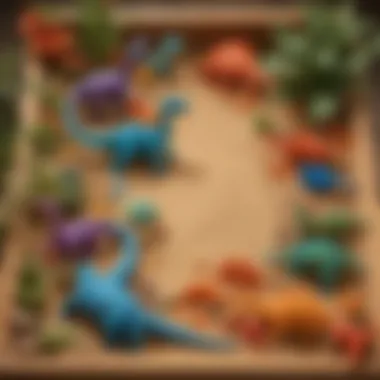
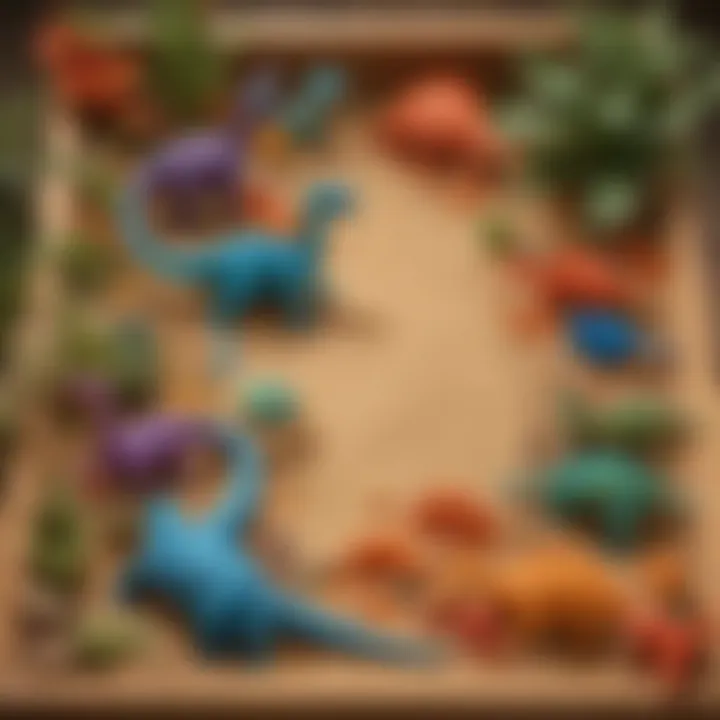
Intro
Dino sand tables are much more than just a play area filled with sand and dinosaur toys. These interactive setups create a unique space for educational play that plants the seeds for a future love of science, particularly paleontology. Sand tables allow children to experiment, discover, and engage with both the past and the present in a hands-on atmosphere. As young learners dig through the sand, they can unearth dinosaur figures, fossils, and even engage in imaginative storylines that promote cognitive skills.
This exploration of Dino sand tables offers an overview of their benefits, design elements, and how they function as excellent educational tools. As we navigate through this topic, we will also provide helpful tips for constructing a dinosaur-themed sand table, whether at home or in educational environments.
Science Fun Facts
Every topic has intriguing facts lurking beneath the surface, and dinosaur studies certainly boast their share.
- Did you know? Some dinosaurs could run really fast. The Velociraptor, for instance, could sprint up to 24 miles per hour!
- Fossils can appear in the most unlikely places. For example, dinosaur footprints have been found on mountain tops.
- The largest dinosaur eggs ever discovered were about 18 inches long—roughly the size of a big basketball.
Children often deploy imaginative narratives within their sand tables. This process potentially enhances not just language skills, but also problem-solving capabilities.
Additionally, certain peculiar stories elevate the narrative around dinosaurs. A particular site in China revealed what is believed to be one of the most complete dinosaur skeletons ever found. Such discoveries can inspire young minds to think about geographical shifts and life history science. Curious inquiries, like “What did dinosaurs eat?” target fundamental paleontological education.
Discover the Wonders of Science
Encouraging scientific curiosity is crucial for child development. With the context of Dino sand tables, the following elements can expand young minds.
- Exploring Various Scientific Concepts: Sand tables encourage hands-on experiments with concepts in geology and biology. As children use measuring tools, such as cups or spoons, they learn about volume and capacity.
- Educational Videos and Animations: Videos explaining dinosaur life cycles or paleontological concepts can contextualize the information kids handle during play.
- Interactive Learning Tools: Incorporating mobile apps that include augmented reality features can present visual representation alongside their physical sand tables.
- Real-Life Applications of Science: Visits to museums or fossil digs can parallel activities conducted at sand tables, reinforcing the importance of paleontology beyond play.
Science Quiz Time
Engaging with content through quizzes can heighten attention and retention of information. Some examples include:
- When did the last dinosaur walk the Earth?
- What is the heaviest dinosaur known?
- Can you name a dinosaur that could fly?
Children could create multiple-choice questions based on the toys within the sand table, integrating a format for informal learning.
- Brain Teasers and Puzzles: Promoting logic puzzles centred on dinosaur facts fosters critical thinking.
. The balance of play with knowledge retention enables children to process complex information naturally. Learning becomes an engaging narrative rather than mere memorization.
Science Experiment Showcase
Conducting fun experiments can be blended with sand tables for further thematic depth:
- Fun and Engaging Experiments: Children can experiment with “archeology” by burying small dinosaur toys and carefully “excavating” them using paintbrushes and small shovels.
- Step-by-Step Instructions: Guide them through creating their own scale models of the Jurassic landscape using background pictures.
- Materials List: Using colored sands, small stones, and mixed figurines creates a dynamic visual presentation.
- Safety Tips and Precautions: Ensure that all materials are age-appropriate with no choking hazards, creating a safe environment for exploration and creativity.
By providing foundational aspects surrounding sand table design, play nuances, and interactivity, children will greatly benefit through immersive discovery experiences. Engaging with Dino sand tables entails inquiry-driven exploration into the scientific world, uniquely blending enjoyment with learning. Above all, fostering such experiences lays the groundwork for a long-term enthusiasm for science.
Intro to Dino Sand Tables
Dino sand tables are a relatively new concept in early childhood education. These interactive and tactile learning environments draw a clear connection between imaginative play and early educational themes, notably the fascinating world of dinosaurs. Setting up such tables not only provides children with an avenue to explore their creativity, but it also lays the groundwork for both collaborative learning and comprehension of scientific concepts. In this article, we will delve into various aspects of dino sand tables, enriching our understanding of their components and educational potential.
Understanding the Concept
Dino sand tables integrate elements of play with education, encouraging children to engage in activities that support their overall cognitive development. These tables typically consist of a sandbox filled with sand alongside various dinosaur figurines and props. Children can excavate, create landscapes, and simulate scenarios among the dinosaurs. It nurtures an environment where they can visually and physically interact with the artifacts, increasing both their engagement and retention of information.

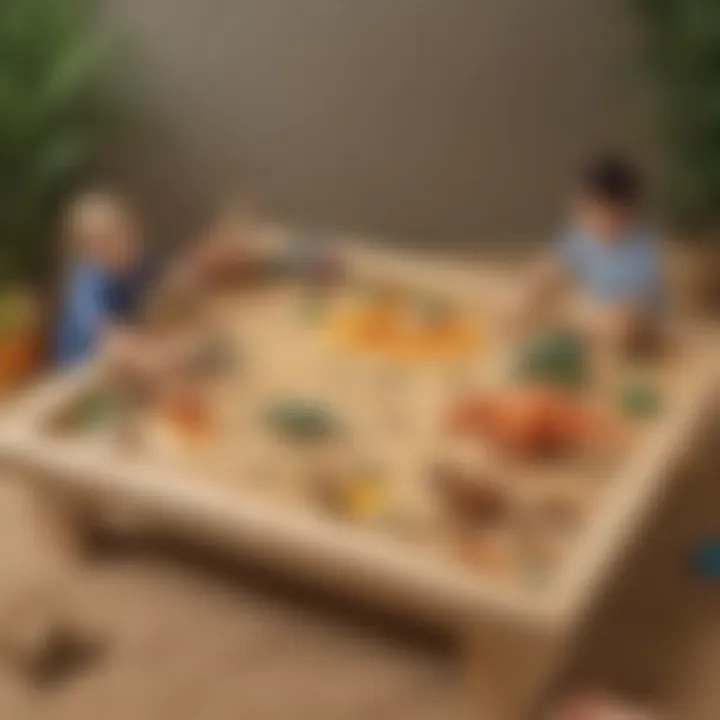
The beauty of this concept lies in its versatility. Dino sand tables can be implemented at home, in schools, or community play areas, thereby enhancing accessibility for many families and communities.
In summary, dino sand tables serve as more than a mere plaything — they are critical educational tools. One may consider reaching out to educators or child development specialists to maximize their function within a broader learning framework.
Importance of Play in Learning
Play is recognized as a vital component in childhood development. Young learners thrive in environments where they can explore, create, and collaborate. The importance of play goes beyond simple amusement; it has significant cognitive, social, and emotional benefits. In the context of dino sand tables, play encourages exploratory learning through hands-on experience and problem-solving.
Benefits of Play-based Learning:
- Encourages Imagination: Children are naturally inventive, and play allows them to construct their worlds.
- Facilitates Social Skills: Collaborative play works as a vehicle for social development, teaching them empathy and communication.
- Enhances Cognitive Functions: Play stimulates curiosity and inquiry, essential skills for understanding scientific concepts.
- Promotes Fine Motor Skills: Activities like digging and arranging enhance physical coordination.
Components of a Dino Sand Table
Creating a Dino sand table is more than merely assembling some materials together. It's about forming a rich environment that encourages exploration and immersive play. The components of a Dino Sand Table contribute to its educational value. It is essential to consider the choice of materials, the selection of toy dinosaurs, and the additional accessories that can enhance the thematic experience. Together, these elements aid in fostering critical skills in young learners, enabling them to engage deeply with imaginative play.
Materials Needed
To set up a functional and enriching Dino sand table, you need certain materials. The basic foundation required is sand, either kinetic or play sand. Kinetic sand is often preferred because it sticks together and is less messy, making it easier to manipulate.
You will also need a container for your sand table. A large plastic bin or a wooden box can work well. Ensure that the container is durable, as it will contain loose sand and other elements. Other useful materials include:
- Dinosaur Figurines: Choosing a variety of sizes and species encourages children to create diverse prehistoric scenes.
- Shelves or Terrains: Consider adding small rocks or platforms to model landscapes reminiscent of the dinosaur age.
- Water Feature: A small basin or container can simulate rivers or lakes, adding an interactive element.
Having the right materials creates a stable platform for learning and exploration. This environment inspires imaginative scenarios among children.
Types of Dinosaurs to Include
The selection of dinosaur figures is vital. Including a diverse range of dinosaur types not only ignites curiosity but also encourages discussions on species characteristics and habitats. Some ideal dinosaur types to use are:
- Tyrannosaurus Rex: A large predator that truly fascinates children.
- Stegosaurus: Known for its distinctive plates, this dinosaur brings uniqueness to play sessions.
- Triceratops: Featuring three horns, this dino can captivate young imaginations with its protective traits.
- Velociraptor: Smaller and agile, this fast dinosaur lends well to interactive scenarios.
Paleontological discussions can start from here. Children can learn the names, sizes, and behaviors of these creatures while playing. This discussion can also pave way for differentiation amongst smaller or larger species. Thus children learn both facts and gameplay.
Additional Accessories
Additional accessories significantly enhance the Dino sand table experience. These items create story possibilities and can lead to enhanced narrative skills.
Recommended accessories include:
- Plants: Artificial ferns or trees help in recreating an authentic prehistoric environment.
- Toy eggs: Rubber eggs can lead to exciting scenarios of dinosaur hatching.
- Katie tickets: These can represent action cards like migration, storm, or feeding day. Children take turns drawing cards to affect the play environment.
- Small Figurines: Include cave people figures or explorers to foster imaginative storytelling.
With these accessories, children will not only play, but they also develop emotional expression and logical thinking skills through role-playing and scenario-based activities.
In summation, understanding each component of a Dino sand table enables parents and educators to create profoundly engaging learning environments. These components do not only occupy space; they inspire education wrapped in creativity.
Creating an Engaging Dino Sand Table Environment
Creating a Dino sand table is not only about the sand and dinosaurs. The entire environment influences the effectiveness of the learning and imagination experiences. An engaging setting encourages interactions and explorations. Its design, location, and natural elements need careful planning. Each aspect contributes to enhancing creativity and extending playtime.

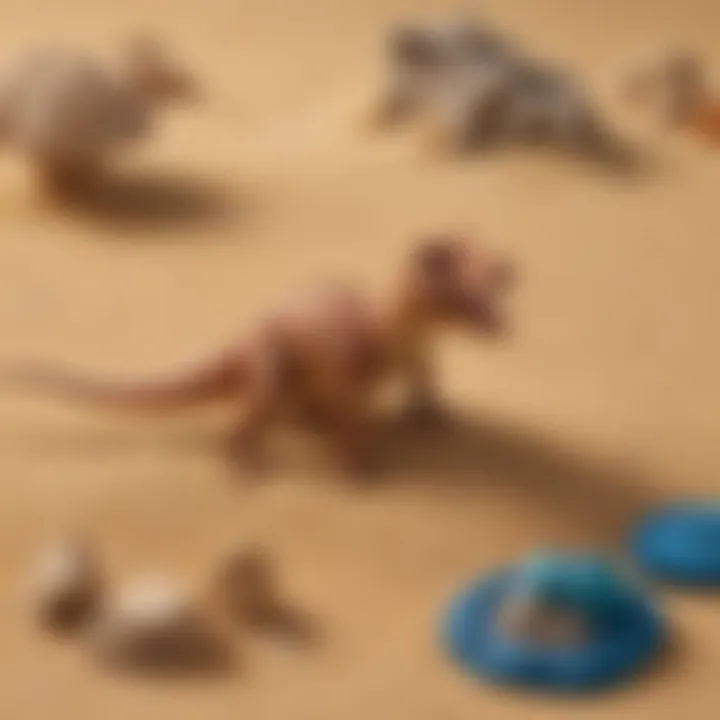
Designing the Table
The structure of the sand table should be functional yet captivating. Select a sturdy table, ideally about waist-high, to facilitate easy access for children. Consider using containers, like blue bins, to create various ecosystems reflecting dinosaur habitats. You might create an areas for sand representing a jungle or a desert. Use borders to separate the various environments. Also, add layers so children can excavate for hidden treasures or fossils. This aspect incites excitement and hands-on learning.
When it comes to the materials, opt for non-toxic paints, sand, and play figures. Avoid hazardous materials. The choice of vibrant colors can inspire creativity. Open-ended spaces allow children to introduce their creativity into the environment. Stick to simple setups initially, then enhance the complexity as children become more familiar with the setting.
Choosing the Right Location
Location plays a large role in the sand table's success. Position the table where there is sufficient room for kids to move around freely and access all areas of the table easily. Sunlight can be beneficial but too much may dry out the sand, making it less enjoyable.
Indoor spaces work well, especially during winter or rainy days. Ensure it's on a surface that can handle sand spills. If outdoors, select a shaded area to protect from direct sunlight. Keeping it secret but accessible can enhance the thrill of discovery.
Proper placement can lead to sustained engagement and reduce distractions, amplifying learning outcomes.
Incorporating Natural Elements
Natural elements enhance the play experience while educating children about the environment. Integrating materials like rocks, wood branches, and leaves can provide a sense of realism. They can serve many purposes in storytelling around dinosaur lore while promoting scientific discussions.
These additions can inspire children's curiosity about ecosystems and habitats. For example, a child may wonder why dinosaurs lived in specific environments, bridging natural and anthropological knowledge. Vary the elements regularly to maintain interest, adapting to seasonal themes might be an option.
Overall, the careful curation of these different elements allows for an educational yet playful atmosphere. Involving children in these decisions could incentivize them to engage more actively, turning the creation itself into a thrilling learning experience. By combining thoughtful design, strategically selecting locations, and integrating natural aspects, the Dino sand table transforms into a profound tool for exploration and enjoyment.
Educational Benefits of Dino Sand Tables
Dino sand tables provide many educational benefits. They promote various aspects of child development while enabling exploratory learning through play. One primary benefit is that they support creativity and imagination, crafting a rich ground for imaginative exploration. With an environment anchored in pretend-play, young learners often engage deeply with their surroundings, thereby stimulating both creativity and innovative thinking.
Enhancing Creativity and Imagination
Dino sand tables allow children to create their own unique worlds. Their imaginations run wild when they can build landscapes, dig for dinosaur bones, and stage various scenarios. The tactile elements—sand, water, and toys—serve to heighten sensory experiences, essential for this age group. For instance, a child may decide to reenact a scene where dinosaurs gather around a water hole or create a hidden cavern for discovery. These activities not only ignite creativity but also help in developing narrative skills. The growing collection of ideas fosters originality which is vital when promoting inventive thinking among children.
Fostering Collaborative Play
Another significant aspect is the encouragement of collaborative play. Children often work together at the sand table, sharing tools or ideas to craft their creations. This cooperation helps improve communication skills, as they must express their thoughts, negotiate roles, and collaborate toward achieving a common goal. A shier child may find their voice in this collaborative environment, diminished barriers can arise. It also supports skill development related to conflict resolution. When disagreements occur, children learn the importance of discussing different viewpoints. This collaborative atmosphere is crucial especially for social skills development, enhancing friendship foundations at an early age.
Preface to Paleontology Concepts
Dinosaur-focused activities foster an early interest in sciences like paleontology. As children interact with dinosaur figures and practice digging through sand, they unknowingly take part in a basic introduction to excavation and fossils. As they engage in these scenarios, mentally visualizing the context of dinosaurs fuels curiosity about how such trees of knowledge came about.
Paleontology is more manageable for children to comprehend when presented through interactive methods. Thus, the design of these sand tables can involve educational prompts or facts about various dinosaur species, spurring deeper learning attached to each element of play.
Young learners grow when play meets education. Dino sand tables offer pathways to discovery.
The End
Understanding the educational benefits of Dino sand tables more holistically expands beyond mere engagement. It encapsulates creativity, teamwork, and science both incisively and engagingly for young minds. With such comprehensive learning opportunities, these tables justify their role as foundational tools in both home and educational environments.
Practical Tips for Parents and Educators
Creating an effective Dino sand table is an important part of fostering creativity and learning in children. Practitioners, whether they are parents or educators, play a crucial role in maximizing the educational benefits derived from this interactive play. Parents and educators should understand what makes dino sand tables beneficial. By providing clear strategies, they can enhance children's engagement and exploration.
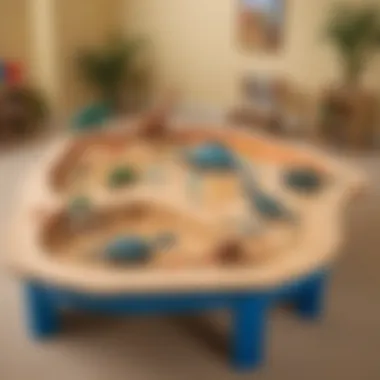
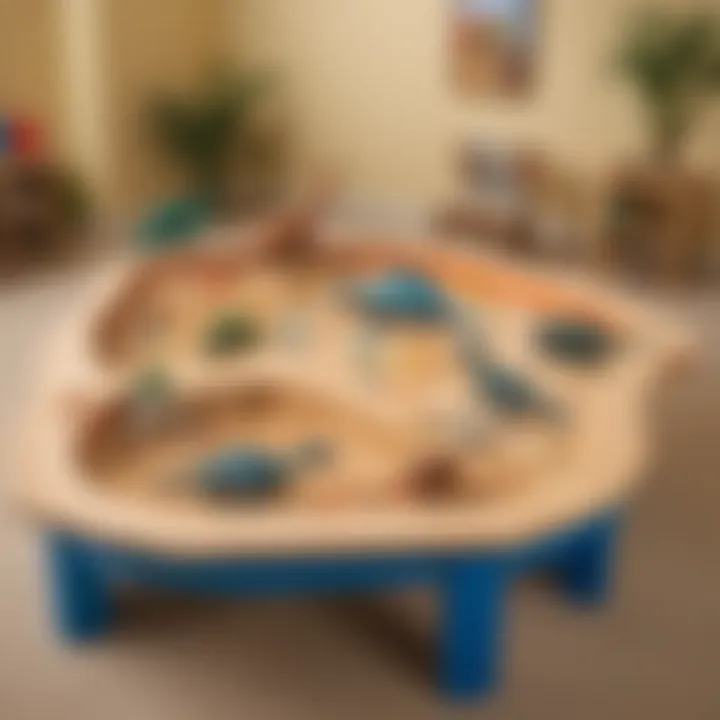
Setting Rules and Guidelines
Establishing clear rules at the beginning sets the stage for orderly play. **Rules can prevent disagreements and frustration ** among children. They help maintain focus while respecting individual ideas and creativity. When creating these rules, keep them age-appropriate and simple. Things like "share the dinosaurs" or "clean up afterward" instill good habits from an early age. Guidelines might need periodic adjustments as children’s skills and understanding develop over time.
Benefits of Setting Rules
- Promotes respect among peers.
- Encourages organized play sessions.
- Helps enrahce children’s decision-making skills.
Facilitating Learning Opportunities
Parents and educators can enhance the experience by intentionally creating scenarios that encourage inquiry and exploration. Posing open-ended questions is one way to facilitate learning. Questions such as, "What do you think dinosaurs ate?" immerse children into deeper conversations. Introducing opportunities for storytelling based in prehistoric environments might also spark interest in reading or research.
Facilitators can choose to rotate the dinosaurs or accessories. By diversifying the components frequent transformations in the table's look can make each play session unique. Special weekly themes about particular dinosaurs or habitats can give additional structure.
Ideas for Facilitating Learning
- Use interactive books about dinosaurs.
- Invite children to create dinosaur tracks in the sand.
- Promote sharing of knowledge and creative input during play.
Observing and Assessing Play
Observation is a valuable tool for assessing how children interact with the components of the dino sand table. Parents and educators should watch carefully. Simple behaviors, like sharing dinosaurs or teaming up to create sand castles, signal beneficial group interactions. At the same time, keep note of a childs learning progression. Look for ignored play patterns or topics that seem to spark enthusiasm. Noting these patterns may define greater themes for future play or even a transition into lesson plans.
Assessment does not always mean formal; correlative notes can help inform activities without the stress of tests or evaluations, which can hinder creativity in children.
Remember, learning should feel like fun, not a chore.
An approachable approach is beneficial. Whether through keeping journals of activities or having discussions about what worked well, these tactics ensure that play is both enjoyable and enlightening. Understanding how different aspects of play fit into educational goals assists adults in guiding young minds into futures rich with knowledge.
The End
Play-based learning retains significant relevance in the realm of childhood education and development. In the context of Dino sand tables, it amplifies the importance of engagement in fostering key skills. These tables facilitate creativity and cognitive activity, providing children a hands-on method to touch concepts related to paleontology.
The Lasting Impact of Play-Based Learning is profound. Children create memories that shape their understanding of the world through meaningful experiences. This impact manifests in several vital areas:
- Cognitive Development: Engaging in play can accelerate outside-the-classroom learning.
- Memory Retention: Interactive experiences lead to better recollection of facts, like dinosaur species and their habitats.
- Emotional Growth: Sharing the Dino sand table with peers helps children develop empathy and communication skills.
The Lasting Impact of Play-Based Learning
The lasting effects of play-based learning form a cornerstone of development in young minds. Engaging children through fun allows them to grasp complex subjects in a simplified and natural way. In the case of Dino sand tables, they embody a fusion of creativity and education.
Research indicates that this hands-on interactive play nourishes curiosity, leading kids to explore more thoroughly. Furthermore, when they can manipulate objects and construct scenarios, they often align these actions with academic subjects, including science and geography.
When children have a medium for active involvement, such as a Dino sand table, it promotes higher concentration levels. They gain techniques essential for focus and resource management. Additionally, experiential learning positively correlates with improved social skills and better teamwork capabilities, as collaboration often occurs during such play.
“Play is the highest form of research.” – Albert Einstein
Encouraging Exploration and Curiosity
Encouraging exploration is a natural byproduct of engaging learning environments like Dino sand tables. Young learners are often ignited by curiosity, pushing them to interact with their environment. Here, they can uncover how dinosaurs lived millions of years ago.
Curiosity can manifest in numerous forms:
- Questions and Inquiry: When children engage with their Dino sand table, they will naturally ask a variety of questions. Why did dinosaurs go extinct? What did they eat? Tackling such inquiries encourages critical thinking.
- Initiating Discovery: As children manipulate the sand table, they may experiment with different elements within the ecosystem. This can lead to a deeper understanding of biodiversity and ecosystems.
- Imaginative Play: Such settings creatively inspire imaginative scenarios, as children simulate prehistoric landscapes. They may deduce benefits of habitats according to varying diets or behaviors of different species.
Curiosity leads to questioning, and with the right support, children learn to seek their answers independently. By encouraging exploration in Dino sand tables, adults foster an examination of scientific phenomena—building confident little learners along the way. Their capacity for inquiry sets a foundation for scholarly success.
Invite that same sense of adventure into every play session. Evaluation occurs naturally, and more importantly, lasting impressions shape perceptive attitudes toward learning and discovery that transcends the confines of formal education. By acknowledging the significance of play, parents and educators can create enriching experiences full of wonder and growth.







